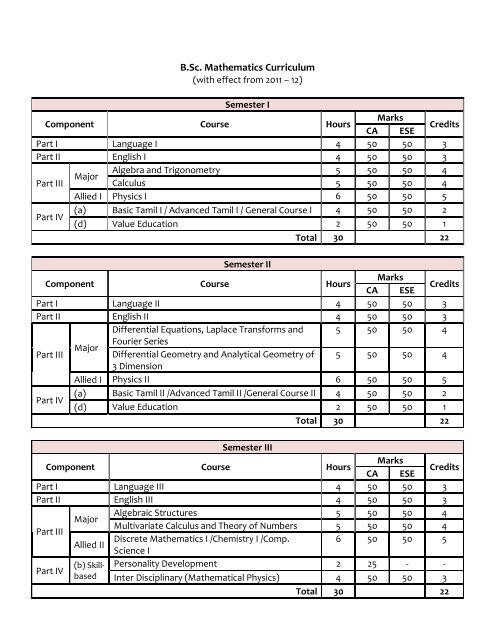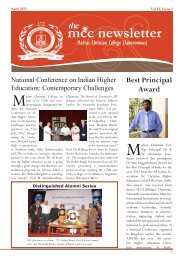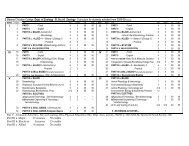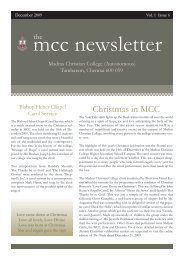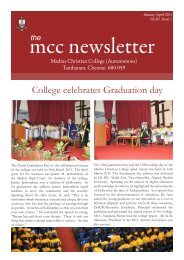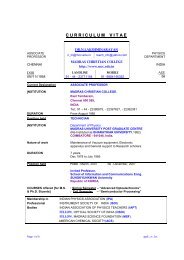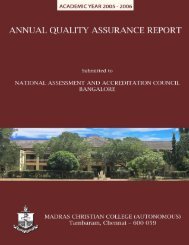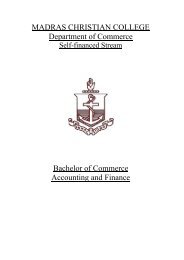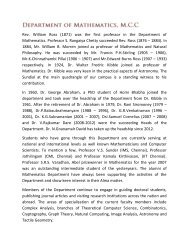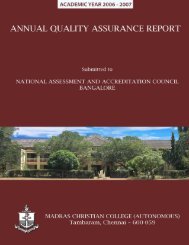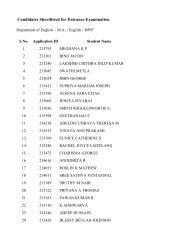B.Sc Curriculum - Madras Christian College
B.Sc Curriculum - Madras Christian College
B.Sc Curriculum - Madras Christian College
Create successful ePaper yourself
Turn your PDF publications into a flip-book with our unique Google optimized e-Paper software.
Department of Mathematics<br />
<strong>Madras</strong> <strong>Christian</strong> <strong>College</strong> (Autonomous)<br />
B.<strong>Sc</strong>. Mathematics <strong>Curriculum</strong><br />
(with effect from 2011 – 12)<br />
Semester I<br />
Component Course Hours<br />
Marks<br />
CA ESE<br />
Credits<br />
Part I Language I 4 50 50 3<br />
Part II English I 4 50 50 3<br />
Algebra and Trigonometry 5 50 50 4<br />
Major<br />
Part III<br />
Calculus 5 50 50 4<br />
Allied I Physics I 6 50 50 5<br />
Part IV<br />
(a) Basic Tamil I / Advanced Tamil I / General Course I 4 50 50 2<br />
(d) Value Education 2 50 50 1<br />
Total 30 22<br />
Semester II<br />
Component Course Hours<br />
Marks<br />
CA ESE<br />
Credits<br />
Part I Language II 4 50 50 3<br />
Part II English II 4 50 50 3<br />
Differential Equations, Laplace Transforms and 5 50 50 4<br />
Fourier Series<br />
Major<br />
Part III<br />
Differential Geometry and Analytical Geometry of 5 50 50 4<br />
3 Dimension<br />
Allied I Physics II 6 50 50 5<br />
Part IV<br />
(a) Basic Tamil II /Advanced Tamil II /General Course II 4 50 50 2<br />
(d) Value Education 2 50 50 1<br />
Total 30 22<br />
Semester III<br />
Component Course Hours<br />
Marks<br />
CA ESE<br />
Credits<br />
Part I Language III 4 50 50 3<br />
Part II English III 4 50 50 3<br />
Part III<br />
Major<br />
Algebraic Structures 5 50 50 4<br />
Multivariate Calculus and Theory of Numbers 5 50 50 4<br />
Allied II<br />
Discrete Mathematics I /Chemistry I /Comp.<br />
6 50 50 5<br />
<strong>Sc</strong>ience I<br />
Part IV<br />
(b) Skillbased<br />
Inter Disciplinary (Mathematical Physics) 4 50 50 3<br />
Personality Development 2 25 - -<br />
Total 30 22
Semester IV<br />
Component Course Hours<br />
Marks<br />
CA ESE<br />
Credits<br />
Part I Language IV 4 50 50 3<br />
Part II English IV 4 50 50 3<br />
Part III<br />
Major<br />
Linear Algebra 5 50 50 4<br />
Advanced Calculus 5 50 50 4<br />
Allied II<br />
Discrete Mathematics II /Chemistry II /Computer 6 50 50 5<br />
<strong>Sc</strong>ience II<br />
(b) Skillbased<br />
Personality Development 2 25 50 3<br />
Part IV<br />
(c) Environmental Studies 4 50 50 2<br />
Total 30 24<br />
Semester V<br />
Component Course Hours<br />
Marks<br />
CA ESE<br />
Credits<br />
Real Analysis 7 50 50 5<br />
Mathematical Statistics 7 50 50 5<br />
Part III Major Numerical Methods 6 50 50 5<br />
Elective: Programming in C / Mathematics of 6 50 50 5<br />
Finance<br />
Part IV<br />
(b) Skillbased<br />
General Elective (Space <strong>Sc</strong>ience) 4 50 50 3<br />
Total 30 23<br />
Semester VI<br />
Component Course Hours<br />
Marks<br />
CA ESE<br />
Credits<br />
Complex Analysis 6 50 50 5<br />
Mechanics 6 50 50 5<br />
Part III Major<br />
Linear Programming 5 50 50 4<br />
Elective: Astronomy / Fluid Dynamics 5 50 50 4<br />
Elective: Formal Languages & Graph Theory / 6 50 50 5<br />
Mathematical Modeling<br />
Part IV<br />
(b) Skillbased<br />
Computer Training 2 - - 3<br />
Total 30 26<br />
Component Extension Activities Hours<br />
Marks<br />
CA ESE<br />
Credits<br />
Part V NCC/NSS/Sports/<strong>Sc</strong>rub Soc./ Dept. Assn. Activities - - - 1<br />
Grand Total 140
Department of Mathematics<br />
<strong>Madras</strong> <strong>Christian</strong> <strong>College</strong> (Autonomous)<br />
Allied and Non-Major Courses Offered by the Department<br />
Allied I:<br />
(Offered to students of Physics and Chemistry Departments)<br />
Semester I<br />
: Allied Mathematics I<br />
Semester II : Allied Mathematics II (for Physics)<br />
Allied Mathematics II (for Chemistry)<br />
Allied II: (Offered to students of Mathematics Department)<br />
Semester III : Discrete Mathematics I<br />
Semester IV : Discrete Mathematics II<br />
General Course: (Offered to students of Departments other than Mathematics)<br />
Semester I<br />
: Basic Mathematics<br />
Semester II : Basic Mathematics<br />
Inter Disciplinary:(Offered to students of Mathematics, Physics and Chemistry Departments)<br />
Semester III : Mathematical Physics<br />
General Elective: (Offered to students of all Departments)<br />
Semester V : Space <strong>Sc</strong>ience<br />
Computer Training: (Offered to students of Mathematics Department)<br />
Semester VI : Computer Training<br />
Environmental Studies:<br />
Semester IV : Environmental Studies (Common to students of all Departments)
Algebra and Trigonometry<br />
Part III (a) – Major Credits: 4<br />
Semester I - Paper I Hours/ Cycle: 5<br />
Algebra<br />
Unit I Hours: 15<br />
Theory of Equations: Introduction to polynomials - Roots of polynomial equations – Imaginary<br />
and irrational roots – Relation between roots and coefficients – Symmetric function of the roots.<br />
Treatment and Content as in<br />
Algebra, Volume – I, T.K. ManicavachagomPillay, T. Natarajan and K.S. Ganapathy,S.<br />
Viswanathan Publishers, 2004.<br />
Chapter 6: Sections 1, 2, 9, 10, 11, 12<br />
Unit II Hours: 15<br />
Transformation of equations – Reciprocal equations.<br />
Treatment and Content as in<br />
Algebra, Volume – I, T.K. ManicavachagomPillay, T. Natarajan and K.S. Ganapathy, S.<br />
Viswanathan Publishers, 2004.<br />
Chapter 6: Sections 13 – 19, 24, 30<br />
Descartes’ rule of signs – Solution by Newton’s and Horner’s method, Cardon’s method of<br />
solution of a cubic polynomial equation with real coefficients.<br />
Treatment and Content as in<br />
Mathematics, Volume – I (First Edition), P. Kandasamy and K. Thilagavathy, S. Chand & Co,<br />
2004.<br />
Paper I: Chapter 1: Section 1<br />
Unit III Hours: 15<br />
Series: Summation of series using Binomial, Exponential and Logarithmic series and<br />
approximations.<br />
Treatment and Content as in<br />
Algebra, Volume – I , T.K. ManicavachagomPillay, T. Natarajan and K.S. Ganapathy, S.<br />
Viswanathan Publishers, 2004.<br />
Chapter 3: Section 10, Chapter 4: Sections 1, 3, 6, 7, 9<br />
Trigonometry<br />
Unit IV Hours: 15<br />
Expansion of cosnx, sin nx, tan nx, cos n x, sin n x –Expansion of sin x, cos x, tan x in terms of x –<br />
Hyperbolic functions<br />
Chapter 3: Sections 1, 2, 3, 4, 5, Chapter 4: Sections 1, 2<br />
Unit V Hours: 15<br />
Logarithms of complex quantities – Sums of sines and cosines of n angles which are in<br />
Arithmetic Progression - Summation of trigonometric series using complex quantities.<br />
Chapter 5: Section 5,Chapter 6: Sections 2, 3<br />
Treatment and Content as in (For Units IV and V)<br />
Trigonometry, S. Narayanan and T.K. ManicavachagomPillay, S.Viswanathan Publishers, 2010.<br />
References<br />
1. Algebra, Analytical Geometry and Trigonometry - I Year – Paper I, by P. R. Vittal and V.<br />
Malini, Margham Publications, Chennai, 2001.<br />
2. Trigonometry by HariKishan, Atlantic, New Delhi, 2005.
Calculus<br />
Part III (a) – Major Credits: 4<br />
Semester I - Paper II Hours / Cycle: 5<br />
Differential Calculus<br />
Unit I Hours: 15<br />
Introduction to differentiation - Successive differentiation - n th derivative – Leibnitz formula for<br />
nth derivative of a product – Partial differentiation – total differential Coefficient– Homogeneous<br />
functions – Euler’s theorem.<br />
Chapter 3: Sections 1.1 – 1.6, 2.1, 2.2, Chapter 8: Sections 1.1 – 1.6<br />
Unit II Hours: 13<br />
Maxima and minima of functions of 2 variables – Lagrange’s method of undetermined<br />
multipliers – simple problems.<br />
Chapter 8: Sections 4.1, 5<br />
Treatment and content as in (For Units I and II)<br />
Calculus, Vol.I, S. Narayanan and T K ManicavachagomPillay,S. ViswanathanPrinters and<br />
Publishers Pvt. Ltd., 2010.<br />
Integral Calculus<br />
Unit III Hours: 17<br />
Introduction to integration - Methods of integration – Integration by parts - Bernoulli’s formula.<br />
Chapter 1: Sections 5, 6.1 – 6.6, 7.1 – 7.5, 8, 9, 10, 12, 15.1<br />
Unit IV Hours: 15<br />
Properties of definite integrals – reduction formulae for standard integrals.<br />
Chapter 1: Sections 11, 13.1 – 13.10, 14<br />
Geometrical Applications of Integration<br />
Unit V Hours: 15<br />
Areas in polar coordinates - Length of the curve (Cartesian and polar coordinates) – Area of<br />
surface of revolution (Cartesian and polar coordinates).<br />
Chapter 2: Sections 1.4, 4.1, 4.2, 5<br />
Treatment and content as in (For Units III, IV and V)<br />
CalculusVol. II, S. Narayanan and T K ManicavachagomPillay,S. ViswanathanPrinters and<br />
Publishers Pvt. Ltd., 2010.<br />
References<br />
1. Mathematics,Volume 1, P. Kandasamy and Thilagavathy, S. Chand, New Delhi, 2004.<br />
2. Calculus, Thomas and Finney, Pearson Education, 9 th Edition, 2006.
Differential Equations, Laplace Transforms and Fourier Series<br />
Part III (a) – Major Credits: 4<br />
Semester II - Paper III Hours/ Cycle: 5<br />
Unit I Hours: 12<br />
Ordinary Differential Equations:Introduction to ordinary differential equations - First order<br />
but of higher degree equations – solvable for p, solvable for x, solvable for y – Clairaut’s form –<br />
simple problems. Second order equation with constant coefficient with particular integrals for<br />
e ax x m , e ax sin mx, e ax cos mx.<br />
Chapter 1: Sections 5.1 – 5.4, 6; Chapter 2: Sections 1, 2, 3, 4<br />
Unit II Hours: 12<br />
Second order differential equation with variable coefficients ax 2 d 2 y/dx 2 + bxdy/dx + cy = g(x) –<br />
method of variation of parameters.<br />
Chapter 2: Sections 8, 10<br />
Unit III Hours: 18<br />
Laplace Transforms: Introduction - Laplace transforms – inverse transform -Application of<br />
Laplace to solution of first and second order linear differential equation with constant<br />
coefficients.<br />
Chapter 5: Sections 1 - 8<br />
Unit IV Hours: 15<br />
Partial Differential Equations: Introduction to partial differential equations (PDE) - Formation<br />
of PDE by eliminating arbitrary constants and arbitrary functions – complete integral – singular<br />
integral – general integral - Standard types f(p,q)=0; f(x,p,q)=0; f(y,p,q)=0; f(z,p,q)=0;<br />
f(x,p)=f(y,q) – Clairaut’s form and Lagrange’s equation Pp+Qq = R . (Simple Problems)<br />
Chapter 4: Sections 1, 2, 3, 5.1 – 5.4, 6<br />
Unit V Hours: 18<br />
Fourier Series: Introduction to Fourier series - Definition – Examples of Fourier series – Even<br />
or odd functions – Fourier series for even and odd functions – Half range expansions. (Simple<br />
problems).<br />
Chapter 6: Sections 1, 2, 3, 4, 5<br />
Treatment and content as in<br />
Calculus, Volume 3, S. Narayanan and T.K. ManicavachagamPillai, S. Vishwanathan<br />
Publications, 2010.<br />
References<br />
1. Engineering Mathematics Volume 3, Dr. M.K. Venkataraman,The National Publishing<br />
Company, 2001.
Differential Geometry & Analytical Geometry of3-Dimensions<br />
Part III (a) – Major Credits: 4<br />
Semester II - Paper IV Hours/ Cycle: 5<br />
Differential Geometry<br />
Unit I Hrs: 12<br />
Curvature – Cartesian formula for radius of curvature - The coordinates of the centre of<br />
curvature – Evolute and involute.<br />
Chapter X: Sections 2.1 – 2.5.<br />
Unit II Hours: 14<br />
Radius of curvature in polar coordinates – p-r equation – Envelopes (definitions and problems<br />
only) – Linear asymptotes (definitions and simple problems only).<br />
Treatment and content as in (For Units I and II)<br />
Calculus, Volume I: S. Narayanan and T K ManicavachagomPillay, S. Viswanathan Printers and<br />
Publishers, 2010.<br />
Chapter X: Sections 1.1 – 1.4, 2.6 – 2.8, Chapter XI: Sections 1 – 4, 5.1 – 5.3, 6<br />
Analytical Geometry of 3-Dimensions<br />
Unit III Hours: 17<br />
The plane – the general equation – several forms of the equations of a plane – angle between<br />
planes – length of perpendicular – equation of the planes bisecting the angle between the planes.<br />
Chapter II: Sections 1 – 11<br />
Unit IV Hours: 16<br />
The Straight Line – symmetrical form – plane and straight line – coplanar lines – shortest<br />
distance between two lines.<br />
Chapter III: Sections 1 –7; Section 8(Sections 8.1, 8.2 are excluded)<br />
Unit V Hours: 16<br />
The Sphere – standard form – plane section – equation of sphere passing through a given circle –<br />
intersection of two spheres – tangent plane to a sphere.<br />
Chapter IV: Sections 1 – 8<br />
Treatment and content as in (For Units III, IV and V)<br />
A text book of Analytical Geometry – Part II (Three dimensions) – T.K. ManicavachagomPillay<br />
and T. Natarajan , S. Viswanathan (Printers and Publishers) Pvt. Ltd 2007.<br />
References<br />
1. Analytical Geometry (3D) and Vector Calculus, S. Arumugam and A.Thangapandi Isaac,<br />
New Gamma Publishing House, Palayamkottai.<br />
2. Text book of Analytical Geometry of Three Dimensions, P.K. Jain and Khalil Ahmed, Wiley<br />
Eastern Ltd, 1986.
Algebraic Structures<br />
Part III (a) – Major Credits: 4<br />
Semester III - Paper V Hours / Cycle: 5<br />
UNIT I Hours: 15<br />
Group Theory: Groups – Subgroups – Counting Principle – Normal Subgroups<br />
Chapter 2: Sections 2.1 – 2.6<br />
UNIT II Hours: 15<br />
Homomorphisms – Automorphisms – Cayley’s theorem – Permutation groups.<br />
Chapter 2: Sections2.7 – 2.10(omit application 1 and 2)<br />
UNIT III Hours: 15<br />
Ring Theory: Definition and examples of Rings – Some special classes of rings –<br />
Homomorphisms.<br />
Chapter 3: Sections 3.1 – 3.3<br />
UNIT IV Hours: 15<br />
Ideals and Quotient rings: More ideals and Quotient ideals – field of quotients of an integral<br />
domain.<br />
Chapter 3: Sections 3.4 – 3.6<br />
UNIT V Hours: 15<br />
Euclidean rings: A particular Euclidean ring – Polynomial Rings – Polynomials over the<br />
rational field.<br />
Chapter 3: Sections 3.7 – 3.10<br />
Treatment and content as in<br />
Topics in Algebra, Second Edition,I.N. Herstein, Wiley Student edition, 2009.<br />
References<br />
1. Modern Algebra, M.L. Santiago, Tata McGraw-Hill Publishing Co. Ltd, 2001.
Multivariate Calculus and Theory of Numbers<br />
Part III (a) – Major Credits: 4<br />
Semester III - Paper VI Hours / Cycle: 5<br />
Unit I Hours: 15<br />
Multiple Integral: Double integral – Polar and Cartesian coordinates – Change of order of<br />
integration – Jacobian – Application to area.<br />
Chapter 5: Sections 1, 2.1, 2.2, 3.1, 5.1, Chapter 6: Section 1<br />
Unit II Hours: 15<br />
Triple integral – Volume under triple integral – Surface area.<br />
Special functions: Beta and Gamma Functions, their properties and simple problems<br />
Chapter 5: Sections 4, 6.3, 7, Chapter 7: Sections 2.1 – 2.3, 3, 4, 5<br />
Treatment and content as in<br />
Calculus, Volume II, S. Narayanan and T.K.ManicavachagomPillay, S. Vishwanathan Publishers<br />
Pvt. Ltd, 2007.<br />
Unit III Hours: 12<br />
Vector Calculus:Introduction–Gradient – Divergent – Curl – Formulae involving –Invariance.<br />
Chapter: 4<br />
Unit IV Hours: 18<br />
Line, Surface and Volume integrals – Theorems of Gauss, Stokes and Green’s (Statements only)<br />
– simple problems.<br />
Chapters: 5, 6<br />
Treatment and content as in<br />
Vector Analysis,<strong>Sc</strong>haum’s outline series, Murray R. Spiegel., Seymour Lipschutz, Dennis<br />
Spellman, Second Edition, McGraw Hill Book Company, 2009.<br />
Theory of numbers<br />
Unit V Hours: 15<br />
Prime and Composite numbers – The sieve of Eratosthenes-Divisors of a given number N –<br />
Euler’s function (N) –Integral part of a real number- The highest power of a prime p contained<br />
in n! – the product of r consecutive integers is divisible by r! – Congruences – Numbers in<br />
arithmetic progressions – Fermat’s Theorem- (statement only) - Wilson’s theorem – (statement<br />
only) – Simple Problems.<br />
Chapter 5: Sections 1 – 17<br />
Treatment and content as in:<br />
Algebra, Volume II by T.K.Manicavachagom Pillay,T.Natarajan, K.S.Ganapathy,<br />
S.Vishwanathan Publishers Pvt.Ltd, 2006.<br />
References<br />
1. Engineering Mathematics, Volume2,Fifth Edition, Dr. M.K. Venkataraman, National<br />
Publishing Company, 2004.<br />
2. Elementary Number Theory, Sixth Edition, David M.Burton,Tata McGraw-Hill Pvt.Ltd,<br />
2009.
Linear Algebra<br />
Part III (a) – Major Credits: 4<br />
Semester IV - Paper VII Hours / Cycle: 5<br />
Unit I Hours: 18<br />
Vector Spaces: Definitions, examples – Subspaces and Quotient Spaces – Sums and Direct<br />
Sums – Linear Independence<br />
Chapter 6: Sections6.1 – 6.4<br />
Unit II Hours: 18<br />
Basis and Dimensions – Homomorphisms – Dual Spaces – Inner Product Spaces<br />
Chapter 6: Sections 6.5 – 6.8<br />
Unit III Hours: 12<br />
Linear Transformations and Matrices: Algebra of Linear Transformations – Eigen values and<br />
Eigenvectors<br />
Chapter 7: Sections 7.1 – 7.2<br />
Unit IV Hours: 14<br />
Matrix Algebra – Trace and Transpose of a Matrix – Rank of Matrix<br />
Chapter 7: Sections 7.3, 7.5, 7.6<br />
Unit V Hours: 13<br />
Determinants – Hermitian and Unitary Transformations.<br />
Chapter 7: Sections 7.8,7.9<br />
Treatment and content as in<br />
Modern Algebra, M.L. Santiago, Tata McGraw-Hill Publishing Co. Ltd, 2001.<br />
References<br />
1. Topics in Algebra, Second Edition,I.N. Herstein, Wiley Student edition, 2009.<br />
2. Linear Algebra, Second Edition, Serge Lang, Addison Wesley Publishing Co., 1970.
Advanced Calculus<br />
Part III (a) – Major Credits: 4<br />
Semester IV - Paper VIII Hours / Cycle: 5<br />
Unit I Hours: 15<br />
Sets and Functions : Sets and elements – Operations on sets – Functions – Real valued<br />
functions – Equivalence – Countability – Real numbers – Least upper bounds.<br />
Chapter 1<br />
Unit II Hours: 15<br />
Sequences of Real Numbers: Definition of a sequence and subsequence – Limit of a sequence –<br />
Convergent sequences – Divergent sequences – Bounded sequences – Monotone sequences –<br />
Operations on convergent sequences – Operations on divergent sequences.<br />
Chapter 2: Sections 2.1 – 2.8<br />
Unit III Hours: 15<br />
Limit superior and limit inferior – Cauchy sequences.<br />
Series of RealNumbers: Convergence and divergence; Series with non-negative numbers;<br />
Alternating series; Conditional convergence and absolute convergence.<br />
Chapter 2: Sections 2.9, 2.10, Chapter 3: Section 3.1 – 3.4<br />
Unit IV Hours: 15<br />
Tests for absolute convergence; Series whose terms form a non-increasing sequence.<br />
Limits and metric spaces: Limit of a function on a real line; Metric spaces; Limits in metric<br />
spaces.<br />
Chapter 3: Sections 3.6, 3.7, 4.1, 4.2 (In 4.2C examples 4 and 5 are omitted), 4.3<br />
Treatment and content as in<br />
Methods of Real Analysis, Richard R. Goldberg (Oxford and IBH Publishing Co.), 1970.<br />
Unit V Hours: 15<br />
Fourier Transform: Complex form of Fourier integral formula, Properties of Fourier transform,<br />
Fourier Cosine and Fourier Sine Transforms, Properties, Convolution, Parseval’s identity.<br />
Chapter 6: Sections 9 – 15.<br />
Treatment and Content as in<br />
Calculus, Volume III, S. Narayanan and ManikavasagamPillai, S. Viswanathan Printers &<br />
Publishers Pvt. Ltd, 2010.<br />
References<br />
1. Principles of Real analysis, Third edition,Walter Rudin, Mc-Graw Hill international edition,<br />
1976.<br />
2. Elements of Real Analysis, Shanti Narayan, M.D. Raisinhhania, S. Chand & Company Ltd.,<br />
Twelfth Revised Edition, 2011.<br />
3. Real analysis, Volume I, K. ChandrasehharaRao, K.S Narayan, S. ViswanathanPrinters &<br />
PublishersPvt. Ltd., 2008.<br />
4. Introduction to Calculus and Analysis, Volume I, Richard Courant, Fiitz John, Springer,<br />
2010.<br />
5. Sequence and Series, S. Arumugam, Issac, New Gamma Publishing House, 1993<br />
6. Transforms and Partial Differential Equations, Fifth revised edition, G. Balaji, 2010.
Real Analysis<br />
Part III (a) – Major Credits: 5<br />
Semester V - Paper IX Hours / Cycle: 7<br />
Unit I Hours: 21<br />
Continuous functions on Metric Spaces: Functions continuous at a point on the real line,<br />
Reformulation,Functions continuous on a metric space, Open sets, Closed sets, Discontinuous<br />
functions on the real line.<br />
Chapter 5<br />
Unit II Hours: 21<br />
Connectedness Completeness and compactness: More about open sets, Connected sets,<br />
Boundedsets and totally bounded sets,Complete metric spaces, Compact metric spaces<br />
Chapter 6: Sections 6.1 – 6.5<br />
Unit III Hours: 21<br />
Continuous functions on a compact metric space, Continuity of inverse functions, Uniform<br />
continuity.Sets of measure zero, Definition of the Riemann integral, Existence of the Riemann<br />
integral (Statement of theorem 7.3a only) –Properties of Riemann integral<br />
Chapter 6: Sections 6.6 – 6.8, Chapter 7: Sections 7.1, 7.2, 7.4<br />
Unit IV Hours: 21<br />
Calculus:Derivatives, Rolle’s theorem, Law of mean, Fundamental theorems of calculus,<br />
Taylor’s theorem.<br />
Chapter 7: Sections 7.5 – 7.8, Chapter 8: Section 8.5<br />
Unit V Hours: 21<br />
Sequences and Series of Functions: Pointwise convergence of sequences of functions –<br />
Uniform convergence of sequences of functions – Consequences of uniform convergence –<br />
Convergence and uniform convergence of series of functions – Integration and differentiation of<br />
series of functions.<br />
Chapter 9: Sections 9.1 – 9.5<br />
Treatment and Content as in<br />
Methods of Real Analysis, Richard R. Goldberg, Oxford and IBH Publishing Co., 1970.<br />
References<br />
1. Transforms and Partial Differential Equations, Fifth revised edition, Walter Rudin, Mc-Graw<br />
Hill international edition, 1976.<br />
2. Real analysis, Volume II, K. ChandrasekharaRao, K.S Narayan, S. ViswanathanPrinters &<br />
Publishers Pvt. Ltd, 2008.<br />
3. Elements of Real Analysis, Shanti Narayan, M.D. Raisinghania, S. Chand & Company Ltd.,<br />
Twelfth Revised Edition, 2011.<br />
4. Modern Analysis, Arumugam, Issac, New Gamma Publishing House, 1993.<br />
5. Elementary Analysis: The theory of Calculus, Kenneth A. Ross, Springer, 2010.<br />
6. Understanding Analysis, Stephen Abbott, Springer, 2008.<br />
7. MetricSpaces, Qamrulhasan Ansari, Narosa Publishing House, 2010.
Mathematical Statistics<br />
Part III (a) – Major Credits: 5<br />
Semester V - Paper X Hours / Cycle: 7<br />
Unit I Hours: 21<br />
Discrete and Continuous Probability Distributions: Random variables – Probability<br />
distributions – Discrete and Continuous, Mathematical expectation, moments, moment<br />
generating function, characteristic function.<br />
Chapters 5: Sections 5.1 – 5.5.2, Chapter 7: Sections 7.1 – 7.3.2, 7.3.5<br />
Unit II Hours: 21<br />
Special Discrete and Continuous Distributions: Introduction – Binomial, Poisson distributions<br />
– Normal distribution.<br />
Chapter 6: Sections 6.1 – 6.2.4, 6.3 - 6.3.5, Chapter 8: Sections 8.1 – 8.4<br />
Unit III Hours: 21<br />
Correlation and Regression: Correlation coefficient, linear regression – equations of lines of<br />
regression.<br />
Chapter 10: Sections 10.1 – 10.6<br />
Unit IV Hours: 21<br />
Tests of Significance – Large Samples: Introduction – Types of Sampling – Large samples –<br />
Testing the significance for a single proportion - Testing of significance for difference of<br />
proportions – Sampling of values of a variable – Sampling distribution of the mean – Confidence<br />
limits - Testing the significance of difference between standard deviations of two large samples.<br />
Chapter 12: Sections 12.1 – 12.8.2<br />
Unit V Hours: 21<br />
Tests of Significance – Small Samples: Introduction – Chi – square distribution – Student’s t –<br />
distribution – Snedecor’s F distribution (Definitions only) – Properties (Statements only) - Tests<br />
of significance based on t, F - distributions, 2 test of goodness of fit, 2 test of independence.<br />
Chapter 13: Sections 13.1 – 13.2.2, 13.5 – 13.7.1,Chapter 15: Sections 15.2 – 15.2.2, 15.3.1,<br />
Chapter 16: Sections 16.1 - 16.3.3<br />
Treatment and Content as in<br />
Mathematical Statistics, J. N. Kapur and H. C. Saxena, 20 th Edition, S. Chand & Co. Ltd., New<br />
Delhi, 2010.<br />
References<br />
1. S. C. Gupta & V. K. Kapoor, Fundamental of Mathematical Statistics, 9 th Edition, Sultan<br />
Chand & Sons, New Delhi, 1994.<br />
2. P. R. Vittal, Mathematical Statistics, Margham Publications, Chennai, 2002.
Numerical Methods<br />
Part III (a) – Major Credits: 5<br />
Semester V - Paper XI Hours / Cycle: 6<br />
Unit I Hrs: 18<br />
Algebraic and Transcendental Equations: Introduction, Errors in numerical computation,<br />
Iterative method, Bisection method, Regula-Falsi method, Newton-Raphson method.<br />
Chapter 3: Sections 3.0 – 3.5<br />
Unit II Hours: 18<br />
Finite Differences: Difference operators, other difference operators, Error propagation in a<br />
difference table, Summation of series.<br />
Chapter 6: Sections 6.0 – 6.4<br />
Unit III Hrs: 18<br />
Interpolation: Introduction, Newton’s interpolation formulae, Bessels’s and Stirling’s formula,<br />
Lagrange’s interpolation formulae, Divided differences, Newton’s divided differences formula,<br />
Inverse interpolation.<br />
Chapter 7: Sections 7.0 – 7.6<br />
Unit IV Hrs: 18<br />
Numerical Differentiation and Integration: Introduction, Derivatives using Newton’s forward<br />
difference formula, Derivatives using Newton’s backward difference formula, Numerical<br />
integration – Trapezoidal rule, Simpson’s one – third, three – eighth rule, Weddle’s rule.<br />
Chapter 8: Sections 8.0 – 8.2, 8.5<br />
Unit V Hrs: 18<br />
Numerical Solutions of Ordinary Differential Equations: Introduction, Taylor’s series<br />
method, Picard’s method, Euler method, Runge-Kutta methods, Predictor-Corrector methods –<br />
Milne’s method, Adam- Bashforth method.<br />
Chapter 10: Sections 10.0 – 10.7<br />
Treatment and content as in<br />
Numerical Methods,S. Arumugam, A. Thangapandi Isaac, A. Somasundaram, SCITECH<br />
Publications Pvt. Ltd., Chennai, 2001.<br />
References<br />
1. Numerical Analysis, B.D.Gupta, Konark Publishers PVT LTD, New Delhi 2003.<br />
2. Numerical Methods, First Edition,P.Kandaswamy, K. Thilagavathy,<br />
K.Gunavathi,S.Chand&Company LTD, New Delhi, 1997.<br />
3. Numerical Methods,V.N. Vedamurthy, N.Ch.S.N.Iyengar, Vikas Publishing House Pvt.<br />
LTD, New Delhi, 1998.
Programming in C<br />
Part III (a) – Major Credits: 5<br />
Semester V - Paper XIIA Hours / Cycle: 6<br />
Elective<br />
Unit I Hrs: 18<br />
Constants, Variables and Data Types – Operators and Expressions – Managing Input and Output<br />
Operations<br />
Chapters: 2, 3, 4<br />
Unit II Hours: 18<br />
Decision Making and Branching – Decision Making and Looping<br />
Chapters: 5, 6<br />
Unit III Hours: 18<br />
Arrays – Character Arrays and Strings<br />
Chapters: 7, 8<br />
Unit IV Hours: 18<br />
User Defined Functions – Structures and Unions<br />
Chapters: 9, 10<br />
Unit V Hours: 18<br />
Pointers – File Management in C<br />
Chapters: 11, 12<br />
Treatment and content as in<br />
Programming in ANSI C (4 th Edn.), E. Balagurusamy, Tata McGraw-Hill Pub. Co. Ltd., New<br />
Delhi, 2008.<br />
References<br />
1. Computer Programming in C, V. Rajaraman, Prentice-Hall of India Pvt. Ltd., New Delhi,<br />
1994.<br />
2. Programming in C, P. Pandiyaraja, Vijay Nicole Imprints Pvt. Ltd., Chennai, 2005.<br />
3. The C Programming Language, B.W. Kernighan and D.M. Ritchie, Prentice-Hall of India<br />
Pvt. Ltd., New Delhi, 1986.<br />
4. Programming with C, B.S. Gottfried, <strong>Sc</strong>haum’s Outline Series, Tata McGraw-Hill, New<br />
Delhi, 1995.
Mathematics of Finance<br />
Part III (a) – Major Credits: 5<br />
Semester V - Paper XIIB Hours / Cycle: 6<br />
Elective<br />
Unit I Hours: 18<br />
Simple Interest and Compound Interest: Simple interest, Equations of value, Partial<br />
payments, Simple discount, Compound Interest, Accumulated value, Discounted value, Finding<br />
the rate, Finding the time, Equations of value, Compound Discount.<br />
Chapters: 3, 4<br />
Unit II Hours: 18<br />
Simple Annuities: Simple Annuities, Accumulated value and discounted value of ordinary<br />
simple annuity, Finding term and interest rate, General annuities, Perpetuities.<br />
Chapters: 5, 6<br />
Unit III Hours: 18<br />
Amortization and Sinking Funds: Amortization of a debt, Outstanding funds, Mortgages,<br />
Sinking funds, Comparison of amortization and sinking fund methods<br />
Chapter: 7<br />
Unit IV Hours: 18<br />
Bonds: Callable bonds, Premium and discount, Price of a bond between bond interest dates,<br />
Finding the yield rate, Other type of bonds<br />
Chapter: 8<br />
Unit V Hours: 18<br />
Capital Budgeting and Depreciation: Net present value, Internal rate of return, Capitalized cost<br />
and capital budgeting, Depreciation<br />
Chapter: 9<br />
Treatment and content as in<br />
Mathematics of Finance, Second edition – Petra Zima, Robert L.Brown, <strong>Sc</strong>haum’s Outlines Tata<br />
McGraw-Hill Edition, 2005<br />
References<br />
1. Business Mathematics, Third Edition, P.R. Vittal, Margham Publications, Chennai, 2005<br />
2. Business Mathematics, V K Kapoor, Sultan Chand & Sons, 2005.<br />
3. Financial Management, Ninth edition, I.M. Pandey, Vikass Publishing house Pvt. Ltd., 2005.<br />
4. Principles of Management Accounting, Fifteenth Edition, S.N. Maheshwari, Majestic Books,<br />
2005.<br />
5. Management Accounting, Second Edition, T.S. Reddy, Hari Prasad Reddy, Margham<br />
Publications, 2004.
Complex Analysis<br />
Part III (a) – Major Credits: 5<br />
Semester VI - Paper XIII Hours / Cycle: 6<br />
Unit I Hours: 16<br />
Analytic functions: Functions of a Complex variable, Mappings, limits, Theorem on limits,<br />
Continuity, derivatives, differentiation formulas, Cauchy Riemann equations, sufficient<br />
conditions, Polar coordinates, Analytic functions, Harmonic functions<br />
Chapter 2: Sections 11, 12, 14,15, 17 - 25<br />
Unit II Hours: 16<br />
Conformal mapping – preservation of angles, Linear fractional transformations, an implicit<br />
form, mappings of the upper half plane, special linear fractional transformations, w = z 2 , w = e z .<br />
Chapter 9: Section94, Chapter 8: Sections 86 – 88, 90, Chapter 2: Section 13<br />
Unit III Hours: 20<br />
Integrals: Contours, Contour integrals, upper bounds for moduli of contour integrals, Anti<br />
derivatives, Cauchy Goursat theorem, Proof of the Cauchy Goursat theorem, Simply and<br />
Multiply connected domains,– Cauchy integral formula – Derivatives of Analytical functions.<br />
Liouville’s theorem and Fundamental theorem of Algebra.– Maximum modulus principle.<br />
Chapter 4: Sections 38 – 50<br />
Unit IV Hours: 19<br />
Convergence of sequence, Convergence of series, Taylor’s series , Laurent series, Absolute and<br />
uniform convergence of power Series, Continuity of sums of power series ,Integration and<br />
differentiation of power series. Uniqueness of series representation<br />
Chapter 5: Sections 51 – 60<br />
Unit V Hours: 19<br />
Residues –Cauchy Residue theorem, Using a single residue, The three types of isolated singular<br />
points, Residues at poles, Zeros of analytical functions, Zeros and poles, Evaluation of real<br />
improper integrals, improper integrals from Fourier Analysis, Jordans lemma, Definite integrals<br />
involving sines and cosines.<br />
Chapter 6: Sections 62 – 69, Chapter 7: Sections 71 – 74, 78<br />
Treatment and content as in<br />
Complex variables and application Seventh Edition by James Ward Brown and Ruel<br />
V.Churchill,Mc-Graw Hill Book Co., International Student Edition, 2003.<br />
References<br />
1. Complex Analysis, Theodore W. gamelan, Springer Verlag, 2008.<br />
2. Complex Analysis, S.Arumugam, A.Thangapandi Isaac, A.Somasundaram,<strong>Sc</strong>itech<br />
publications(India)Pvt,Ltd.Dec2010.<br />
3. ComplexAnalysis,T.K.ManicavachagomPillay,Dr.S.P.Rajagopalan,Dr.R.Sattanathan,S.Visw<br />
anathanPrinters&PublishersPvt. Ltd.,2008.<br />
4. Complex Analysis, S.G.Venkatachalapathy, Margham Publication 2009.<br />
5. Theory of functions of a Complex Variable, Shanti Narayan, Dr.P.K.Mittal, S. Chand and<br />
Company Ltd.2010.
Mechanics<br />
Part III (a) – Major Credits: 5<br />
Semester VI - Paper XIV Hours / Cycle: 6<br />
Unit I Hrs: 18<br />
Statics: Concurrent system of forces: Triangle law of forces, Lami’s Theorem, Polygon law of<br />
forces, Moment of a force, Varignon’s Theorem.<br />
Chapter 2: Sections 2.1 – 2.9, 2.12 – 2.13, 2.14 – 2.16, Chapter 3: Sections 3.6, 3.7<br />
Unit II Hrs: 18<br />
Friction: Laws of friction, Angle of friction, Ladder problems.<br />
Chapter 4: Sections 4.1 – 4.5<br />
Treatment and content as in Statics, K.Viswanatha Naik, M.S.Kasi, Emerald Publishers,<br />
(1992)<br />
Dynamics - Energy: Kinetic energy, Conservation of energy, Conservation forces.<br />
Chapter 3: Sections 3.8 – 3.14<br />
Unit III Hrs: 18<br />
Projectiles: Trajectory, Horizontal and inclined planes.S.H.M : General solution, Elastic strings,<br />
Composition of two S.H.M, Simple Pendulum, Seconds Pendulum.<br />
Chapter 5: Sections 5.1 – 5.7, Chapter 8: Sections 8.1 – 8.4, Chapter 9: Sections 9.3 – 9.5<br />
Unit IV Hrs: 18<br />
Motion of a particle along a curve: Conical Pendulum, Motion on a curved track, Circular<br />
track, Banked up track, Vertical curve, Motion on the outside of a smooth vertical circle, inside a<br />
vertical circle.<br />
Chapter 9: Sections 9.8 – 9.14<br />
Unit V Hours: 18<br />
Central Orbits: Central forces, Differential equation of a central orbit, Pedal equation, Apse, p-r<br />
equation, Inverse square law.<br />
Chapter 10: Sections 10.1 – 10.8, 10.11<br />
Treatment and content as in<br />
Dynamics, K.Viswanatha Naik, M.S. Kasi, Emerald Publishers, 1992.<br />
References<br />
1. Mechanics, P.Duraipandian, Laxmi Duraipandian, Muthamizh Jayapragasam,S.Chand &<br />
Company Ltd publications, 2010.<br />
2. A text book of Statics, Dr.M.K.Venkataraman, Agasthiar Publications, 1994.<br />
3. A text book of Dynamics, Dr.M.K.Venkataraman, Agasthiar Publications ,1994.
Linear Programming<br />
Part III (a) – Major Credits: 4<br />
Semester VI - Paper XV Hours / Cycle: 5<br />
Unit I: Hours: 14<br />
Linear programming Problem -Mathematical Formulation-Graphical Solution and<br />
Extension: Introduction- Linear Programming Problem –Mathematical formulation of L.P.P –<br />
Illustration on Mathematical formulation of L.P.P.Graphical Solution Method – Some<br />
Exceptional Cases – General Linear Programming Problem –Canonical and Standard Forms of<br />
L.P.P.<br />
Chapter 2: Sections 2.1 – 2.4, Chapter 3: Sections 3.1 – 3.5<br />
Unit II: Hours: 16<br />
Linear programming Problem -Simplex Method:Introduction-Fundamental Properties of<br />
Solutions(Theorems-Statement only)-The Computational Procedure-Use of Artificial<br />
Variables(only Big-M Method or Method of Penalties)-Degeneracy in Linear Programming .<br />
Chapter 4: Sections 4.1 – 4.5<br />
Unit III: Hours: 16<br />
Duality in Linear Programming: Introduction –General Primal-Dual Pair-Formulating a Dual<br />
Problem- Primal-Dual Pair in Matrix Form-Duality Theorems-Complementary Slackness<br />
Theorem- Duality and Simplex Method.<br />
Chapter 5: Sections 5.1 – 5.7<br />
Unit IV: Hours: 16<br />
Transportation Problem:Introduction –LP formulation of the transportation Problem –<br />
Existence of solutions in T.P-Duality in Transportation Problem-The Transportation table-Loops<br />
in Transportation tables-Triangular Basis in a T.P-Solution of a Transportation Problem –Finding<br />
an Initial Basic Feasible Solution –Test for Optimality-Economic Interpretation of u<br />
j<br />
’s and v<br />
j<br />
’s<br />
- Degeneracy in Transportation Problem - Transportation Algorithm(Modi Method)-Stepping<br />
Stone Solution Method-Some Exceptional Cases.<br />
Chapter 10: Sections 10.1 – 10.15<br />
Unit V: Hours: 13<br />
Assignment Problem:Introduction- Mathematical Formulation of the problem-Solution<br />
Methods of Assignment Problems –Special Cases in Assignment Problem.<br />
Sequencing Problem: Introduction-Problem of Sequencing-Basic terms Used in Sequencing-<br />
Processing n jobs through Two Machines.<br />
Chapter 11: Sections 11.1 – 11.4; Chapter 12: Sections 12.1 – 12.4<br />
Treatment and content as in<br />
Operations Research, Kanti Swarup, P.K. Gupta, Man Mohan , Sultan Chand and Sons Ltd,<br />
New Delhi,15 th Edition,2010.<br />
References<br />
1. Operations Research, Prem Kumar Gupta, D.S. Hira, S. Chand &Company Ltd, Ram Nagar,<br />
New Delhi, 2007.<br />
2. Operations Research Theory and Applications, Third Edition,J.K.Sharma, Macmilan India<br />
Ltd., 2007.
Astronomy<br />
Part III (a) – Major Credits: 4<br />
Semester VI - Paper XVIA (Elective)<br />
Hours /Cycle:5<br />
Unit I Hours: 17<br />
Spherical Trigonometry: Sphere – Great circles and small circles – axis and poles of a circle –<br />
Distance between two points on a sphere – angle between two circles – Secondaries – angular<br />
radius – length of an arc of a small circle – spherical triangle – cosine formula, sine formula,<br />
cotangent formula (without proof)<br />
Celestial Sphere: Celestial sphere – diurnal motion, celestial axis and equator – celestial<br />
horizon – Zenith and Nadir – Celestial Meridian – Cardinal points – Declination circles –<br />
Verticals – Parallactic angle – Rising and setting – Transit or culmination – due east, west, north,<br />
south – annual motion of sun – First point of Aries and First point of Libra – Equinoxes and<br />
Solstices – Celestial coordinates – Horizontal, Equatorial, Meridian, ecliptic systems – Hour<br />
Angle and azimuth at rising and setting – latitude of a place – Circumpolar Star – Twilight.<br />
Chapter I:Sections 1 – 8, 11 – 13, 21 – 23, Chapter II:Sections 39 – 82,<br />
Chapter III:Sections 111 – 116<br />
Unit II Hours: 15<br />
Refraction: Laws of refraction – Astronomical refraction – Tangent formula – General effects –<br />
Effects on rising or setting – Effect on R.A, declination – effect on small horizontal arc, vertical<br />
arc, any small arc – Cassini’s Formula – Horizontal refraction<br />
Concepts of geocentric, heliocentric parallax, aberration, Precession and Nutation (definitions<br />
only)<br />
Overview of the universe – The solar system in general – the other planets – comets – galaxies.<br />
Chapter IV: Sections 117 – 131, Chapter V:Sections 135, 136, 140 – 145,<br />
Chapter VIII: Sections 190, 191, 194, Chapter IX: Sections 195, 196,<br />
Chapter X: Sections 204 – 206<br />
Chapter XVII: Sections 327 - 340<br />
Unit III Hours: 15<br />
Kepler’s Laws: Kepler’s Laws of planetary motion – Longitude of Perigee – Forward motion of<br />
the apse line – eccentricity of earth’s orbit – To fix the position of a planet in its elliptical orbit –<br />
To express v as a series of u- mean anomaly – Kepler’s equation – To express u as a series in m.<br />
Planetary Phenomena: Phases of the planets – Relation between sidereal and synodic period of<br />
a planet, brightness of the planets.<br />
Chapter VI: Sections 146-149,156-160, Chapter XIV: Sections 285 – 297.<br />
Unit IV Hours: 13<br />
Time: Equation of time – Seasons – Calendar – Conversion of time<br />
Chapter VII: Sections 166 – 170, 172 – 189
Unit V Hours: 15<br />
Moon: Relation between sidereal and synodic month – elongation – Phases of moon.<br />
Eclipses: Umbra and Penumbra – Lunar eclipse – Solar eclipse – Condition for occurrence of a<br />
solar eclipse – angular radius of the cross section of the shadow cone where moon enters – length<br />
of earth’s shadow – condition for the occurrence of a solar eclipse – ecliptic limits – maximum<br />
and minimum number of eclipses near a node - in a year – Saros of Chaldeans<br />
Chapter XII: Sections 229-241, Chapter XIII:Sections 256 – 275<br />
Treatment and content as in<br />
Astronomy by S. Kumaravelu and Susheela Kumaravelu, 2005.<br />
References<br />
1. Text Book on Spherical Astronomy, Sixth Edition,W.M. Smart, VIKAS Publishing House<br />
Pvt. Ltd., 1979.<br />
2. Exploration of the Universe, Second Edition, George Abell, 1981.<br />
Observational Astronomy<br />
1. Systems of coordinates – a practical study.<br />
2. Observation of moon – at different phases.<br />
3. Observation of planets.<br />
4. Observation of satellites of planets.<br />
5. Identification of constellations.
FLUID DYNAMICS<br />
Part III (a) – Major Credits: 4<br />
Semester VI - Paper XVIB (Elective)<br />
Hours /Cycle:5<br />
Unit I Hours: 15<br />
Kinematics of fluids in motion: Real fluids and ideal fluids – velocity of a fluid at a point –<br />
stream lines and path lines; steady and unsteady flows – the velocity potential – the vorticity<br />
vector – local and particle rates of change – the Equations of continuity – worked examples –<br />
Acceleration of fluid – Conditions at a rigid boundary – general analysis of fluid motion.<br />
Chapter 2: Sections 2.1 – 2.11<br />
Unit II Hours: 15<br />
Equations of motions of a fluid: Pressure at a point in a fluid at rest – Pressure at a point in<br />
moving fluid – Conditions at a boundary of two inviscid immiscible fluids – Euler’s equation of<br />
motion, Bernoulli’s equation – worked examples.<br />
Chapter 3: Sections 3.1 – 3.6<br />
Unit III Hours: 15<br />
Discussion of the case of steady motion under conservative body forces – some flows involving<br />
axial symmetry – some special two dimensional flows – Impulsive motion – some further aspects<br />
of Vortex motion.<br />
Chapter 3: Sections 3.7, 3.9 – 3.12<br />
Unit IV Hours: 15<br />
Some Three dimensional flows: Introduction – Sources, sinks and doublets – Images in a rigid<br />
infinite plane – Images in solid spheres – Axisymmetric flows; Stoke’s stream function.<br />
Chapter 4: Sections 4.1 – 4.5<br />
Unit V Hours: 15<br />
Some Two-dimensional flows:Meaning of two dimensional flow – use of cylindrical polar<br />
coordinates – stream function – the complex potential for two dimensional, irrotational,<br />
incompressible flow – the complex velocity potentials for standard two dimensional flows –<br />
some worked examples – Two dimensional image systems – Milne Thompson circle Theorem –<br />
The Theorem of Blasius.<br />
Chapter 5: Sections 5.1 – 5.9<br />
Treatment and content as in:<br />
Text book of Fluid Dynamics, F.Chorlton, CBS Publishers and Distributors, 1985.<br />
References<br />
1. Fluid Dynamics, Walther Kaufmann, Tata McGraw-Hill, 1963.<br />
2. Fluid Mechanics and its Applications, Vijay Gupta, Santosh K. Gupta, Wiley Eastern Ltd.,<br />
1984.
Formal Languages and Graph Theory<br />
Part III (a) – Major Credits: 5<br />
Semester VI - Paper XVII A (Elective) Hours /Cycle: 6<br />
UNIT I Hours: 18<br />
Phrase-Structure languages, Closure properties:Four types of grammars, Chomskian<br />
hierarchy, Closure operations, Derivation trees, Ambiguity.<br />
Chapter 2: Sections 2.1 – 2.4, Chapter 3: Sections 3.1, 3.2, Chapter 4: Sections 4.1, 4.2<br />
UNIT II Hours: 18<br />
Normal form of CFG, Property of CFL:Auxiliary lemmas, Chomsky Normal form, u-v<br />
theorem.<br />
Chapter 4: Sections 4.3, 4.4 (upto Theorem 4.1 and examples 4.10, 4.11, 4.12), 4.5 (up to<br />
Theorem 4.3 and example 4.15)<br />
UNIT III Hours: 18<br />
Finite State Automata: Finite Automaton, Non-Deterministic Finite Automaton, Finite<br />
Automata and Regular sets, Closure properties of Regular sets, Charaterisation of the family of<br />
Regular sets.<br />
Chapter 5: Sections 5.1 – 5.4 (up to Theorem 5.7 and examples using it)<br />
Treatment and content as in:<br />
Formal Languages and Automata, Rani Siromoney, CLS, 1984.<br />
UNIT IV Hours: 18<br />
Introduction, Paths and Circuits: Graphs, Incidence and degree of a vertex, Walks, Paths and<br />
Circuits, Euler graphs, Operations on graphs, Hamiltonian paths and circuits, Travelling<br />
Salesman Problem<br />
Chapter 1: Sections 1.1 – 1.6, Chapter 2: Sections 2.1 – 2.10<br />
UNIT V Hours: 18<br />
Trees, Fundamental Circuits, Cut-sets and Cut-vertices:Trees, Properties of trees, On<br />
counting trees, Spanning trees, Fundamental circuits, Cut-sets, Properties of cut-sets,<br />
Connectivity and separability.<br />
Chapter 3: Sections 3.1 – 3.10, Chapter 4: Sections 4.1 – 4.5<br />
Treatment and content as in:<br />
Graph Theory with Applications to Engineering and Computer <strong>Sc</strong>ience, Narsingh Deo, Prentice<br />
Hall of India Pvt. Ltd., 2005.<br />
References<br />
1. D.P. Acharjya, Theory of Computation, MJP Publications, 2010.<br />
2. Peter Linz, An Introduction to Formal Languages and Automata, Narosa Publications, Fourth<br />
Edition, 2010.<br />
3. Kamala Krithivasan and R. Rama, Introduction to Formal Languages, Automata Theory and<br />
Computation, Pearson, Chennai, 2011.<br />
4. S.P. Rajagopalan and R. Sattanathan, Graph Theory, Margham Publications, Chennai, 2009.<br />
5. S. Arumugam and S. Ramachandran, Invitation to Graph Theory, SCITECH Publications<br />
(India) Pvt. Ltd., Chennai, 2002.<br />
6. S.A. Choudum, A First Course in Graph Theory, Macmillan India Ltd., New Delhi, 1999.
Mathematical Modeling<br />
Part III (a) – Major Credits: 5<br />
Semester VI - Paper XVII B (Elective) Hours /Cycle: 6<br />
UNIT I Hours: 18<br />
Mathematical Modeling through Ordinary Differential Equations of First order: Linear<br />
Growth and Decay Models – Non-Linear Growth and DecayModels – Compartment Models –<br />
Dynamic problems – Geometrical problems.<br />
Chapter 2: Sections 2.1 – 2.6<br />
UNIT II Hours: 18<br />
Mathematical Modeling through Systems of Ordinary Differential Equations of First<br />
Order: Population Dynamics – Epidemics – Compartment Models –Economics – Medicine,<br />
Arms Race, Battles and International Trade – Dynamics.<br />
Chapter 3: Sections 3.1 – 3.6<br />
UNIT III Hours: 18<br />
Mathematical Modeling through Ordinary Differential Equations of Second Order:<br />
Planetary Motions – Circular Motion and Motion of Satellites –Mathematical Modeling through<br />
Linear Differential Equations of Second Order –Miscellaneous Mathematical Models.<br />
Chapter 4: Sections 4.1 – 4.4<br />
UNIT IV Hours: 18<br />
Mathematical Modeling through Difference Equations: Simple Models – BasicTheory of<br />
Linear Difference Equations with Constant Coefficients – Economicsand Finance – Population<br />
Dynamics and Genetics – Probability Theory.<br />
Chapter 5: Sections 5.1 – 5.5<br />
UNIT V Hours: 18<br />
Mathematical Modeling through Graphs: Solutions that can be ModelledThrough Graphs –<br />
Mathematical Modeling in Terms of Directed Graphs, SignedGraphs, Weighted Digraphs and<br />
Unoriented Graphs.<br />
Chapter 7: Sections 7.1 – 7.5<br />
Treatment and content as in<br />
Mathematical Modeling, J.N. Kapur, Wiley Eastern Limited, New Delhi, 1988.<br />
References<br />
1. J.N. Kapur, Mathematical Models in biology and Medicine, EWP, New Delhi,1985.
Allied I: Allied Mathematics – I<br />
(For both Physics and Chemistry)<br />
Part III (b) - Allied I Credits: 5<br />
Semester I - Paper I Hours / Cycle: 6<br />
Unit I Hours: 18<br />
Introduction to Partial Differentiation -Partial Differentiation – Total differential co-efficient -<br />
Euler’s Theorem – Maxima and Minima of functions of two variables – Lagrange’s method of<br />
undetermined multipliers.<br />
Treatment and Content as in<br />
Calculus – Volume I by S. Narayanan and T. K. ManicavachagomPillay, S. Viswanathan<br />
Printers & Publishers Pvt. Ltd., 2009.<br />
Chapter 8: Sections 1.1 – 1.6, 4, 5<br />
Jacobian - Definition and simple problems.<br />
Treatment and Content as in<br />
Calculus – Volume II by S. Narayanan and T. K. ManicavachagomPillay, S. Viswanathan<br />
Printers & Publishers Pvt. Ltd., 2009.<br />
Chapter 6: Sections 1.1, 2.3, 2.4<br />
Unit II Hours: 18<br />
Introduction - Integration of irrational functions - Methods of integration of the following types<br />
only:<br />
dx<br />
( px q)<br />
<br />
,<br />
2 <br />
dx,<br />
2 ax 2 2<br />
bx c dx, px<br />
q<br />
ax bx c dx ,<br />
ax bx c ( ax bx c)<br />
dx<br />
dx<br />
<br />
and<br />
2<br />
<br />
<br />
x k ax bx c <br />
2<br />
<br />
2<br />
ax b cx d <br />
-<br />
Properties of Definite integrals - Integration by parts - Bernoulli’s formula.<br />
Treatment and Content as in<br />
Calculus – Volumes II by S. Narayanan and T. K. ManicavachagomPillay, S. Viswanathan<br />
Printers & Publishers Pvt. Ltd., 2007.<br />
Chapter 1: Sections 8, 11, 12, 15.1<br />
Unit III Hours: 18<br />
Second order linear differential equations with constants co-efficients – Methods of finding<br />
particular integral of the functions of e ax , sin ax or cos ax, e ax v(x), x m .<br />
Fourier series – Even and odd functions – Half range Fourier series.<br />
Treatment and Content as in<br />
Calculus – Volume III by S. Narayanan and T. K. ManicavachagomPillay, S. Viswanathan<br />
Printers & Publishers Pvt. Ltd., 2007.<br />
Chapter 2: Sections 1 – 4; Chapter 6: Sections 1 – 5
Unit IV Hours: 18<br />
Analytical geometry of three dimensions: Direction Cosines – direction ratios. The plane: Three<br />
forms of an equation of a plane (without derivations) – Angle between the two planes – Length<br />
of the perpendicular from a point to the plane (simple problems only) – The straight line.<br />
Treatment and Content as in<br />
A Textbook of Analytical Geometry Part - II – Three Dimensions by T. K.<br />
ManicavachagomPillay and T. Natarajan, S. Viswanathan Printers & Publishers Pvt. Ltd., 2009.<br />
Chapter 1: Sections 7, 8; Chapter 2: Sections 1 – 3, 5 – 7, 10; Chapter 3: Sections 1 – 4<br />
Unit V Hours: 18<br />
Theory of equations: Nature of roots – Relation between the coefficients and the roots of an<br />
algebraic equation – Transformation of equations – Reciprocal equation.<br />
Treatmentand Content as in<br />
Algebra Volume – I by T. K. ManicavachagomPillay, T. Natarajan, K.S. Ganapathy,<br />
S. Viswanathan Printers and Publishers Pvt. Ltd., 2004.<br />
Chapter 6: Sections 9 – 11, 15,16<br />
Matrices: Rank of a matrix – Eigen values and Eigen vectors – Cayley Hamilton theorem.<br />
Treatmentand Content as in<br />
Algebra Volume – II by T. K. ManicavachagomPillay, T. Natarajan, K.S. Ganapathy,<br />
S. Viswanathan Printers and Publishers Pvt. Ltd., 2004.<br />
Chapter 2: Sections 11 – 16<br />
References<br />
1. Allied Mathematics (in single volume) P. R. Vittal, Margham Publications, Reprint 2005.<br />
2. Allied Mathematics (For Physics, Chemistry and Computer <strong>Sc</strong>ience Major Courses of<br />
<strong>Madras</strong> University) by A. Singaravelu (Meenakshi Traders), 2001.
Allied I: Allied Mathematics - II<br />
(For Chemistry)<br />
Part III (b) – Allied Credits: 5<br />
Semester II– Paper II Hours/ Cycle: 6<br />
Unit I: Partial Differential Equations Hours: 18<br />
Introduction to Partial Differential Equations - Order and derivation of Partial Differential<br />
Equations, Different integrals of Partial Differential Equations, Solution of Partial Differential<br />
Equations in some simple cases, Standard types of first order Partial Differential Equations<br />
(standard types I to IV).<br />
Treatment and Content as in<br />
Calculus – Volume III by S. Narayanan and T. K. ManicavachagomPillay, S. Viswanathan<br />
Printers & Publishers Pvt. Ltd., 2007.<br />
Chapter 4: Sections 1 – 4, 5.1 – 5.4<br />
Unit II: Multiple Integrals Hours: 18<br />
Introduction - Definition of double integral, evaluation of double integral(including changing the<br />
order of integration), triple integrals, application of multiple integrals (area enclosed between<br />
curves), volume as a triple integral.<br />
Treatment and Content as in<br />
Calculus – Volume II by S. Narayanan and T. K. ManicavachagomPillay, S. Viswanathan<br />
Printers & Publishers Pvt. Ltd., 2007.<br />
Chapter 5: Sections 1, 2, 4, 5.1, 6.3<br />
Unit III:Vector Calculus Hours: 18<br />
Gradient, Divergence and curl, Vector identities, Line integral, Surface integral, Volume<br />
integral.<br />
Treatment and content as in<br />
Ancillary Mathematics Book III by S.Narayanan and T. K. ManicavachagamPillay,<br />
S. Viswanathan Publishers, 1999.<br />
Vector analysis – Chapter 2: Sections 1 – 12; Chapter 4: Sections 1 – 5<br />
Unit IV:Vector Integration Hours: 18<br />
Statement of Gauss divergence theorem, Green’s Theorem, Stokes theorem (without proof) and<br />
Applications.<br />
Treatment and content as in<br />
Ancillary Mathematics Book III by S.Narayanan and T. K. ManicavachagamPillay,<br />
S. Viswanathan Publishers, 1999.<br />
Vector analysis – Chapter 4: Sections 6 – 10
Unit V: Groups Hours: 18<br />
Binary operation, Definition of groups, Abelian group, Infinite group, properties of groups,<br />
Composition table for finite sets, Addition modulo m, Multiplication modulo m, Permutation and<br />
order of an element, cyclic permutation, Integral powers of an element of a group, Isomorphism<br />
of groups, Cayley’s theorem, cyclic group, Properties of cyclic groups.<br />
Treatment and content as in<br />
Ancillary Mathematics Book I by S.Narayanan, T. K. ManicavachagomPillay, Kandaswamy, R.<br />
HanumanthaRao, 1999.<br />
Chapter 8: Section II: 1 – 6<br />
References<br />
1. Allied Mathematics by P. R. Vittal, Margham Publications, Reprint 2005.<br />
2. Allied Mathematics – Paper II – Second Semester by P. Kandaswamy and K. Thilagavathy,<br />
S. Chand & Co., Reprint 2010.<br />
3. Ancillary Mathematics Paper IV by Arumugam and Isaac , New Gamma Publishing House,<br />
1992.
Allied I: Allied Mathematics - II<br />
(For Physics)<br />
Part III (b) – Allied Credits: 5<br />
Semester II– Paper II Hours/ Cycle: 6<br />
Unit I: Partial Differential Equations Hours: 18<br />
Order and derivation of Partial Differential Equations, Different integrals of Partial Differential<br />
Equations, Solution of Partial Differential Equations in some simple cases, Standard types of<br />
first order Partial Differential Equations (standard types I to IV).<br />
Treatment and Content as in<br />
Calculus – Volume III by S. Narayanan and T. K. ManicavachagomPillay, S. Viswanathan<br />
Printers & Publishers Pvt. Ltd., 2007.<br />
Chapter 4: Sections 1 – 4, 5.1 – 5.4<br />
Unit II: Multiple Integrals Hours: 18<br />
Definition of double integral, evaluation of double integral(including changing the order of<br />
integration), triple integrals, application of multiple integrals (area enclosed between curves),<br />
volume as a triple integral.<br />
Treatment and Content as in<br />
Calculus – Volume II by S. Narayanan and T. K. ManicavachagomPillay, S. Viswanathan<br />
Printers & Publishers Pvt. Ltd., 2007.<br />
Chapter 5: Sections 1, 2, 4, 5.1, 6.3<br />
Unit III:Vector Calculus Hours: 18<br />
Introduction - Gradient, Divergence and curl, Vector identities, Line integral, Surface integral,<br />
Volume integral.<br />
Treatment and content as in<br />
Ancillary Mathematics Book III by S.Narayanan& T. K. ManicavachagamPillay, S.<br />
Viswanathan Publishers, 1999.<br />
Vector analysis – Chapter 2: Sections 1 – 12, Chapter 4: Sections 1 – 5<br />
Unit IV:Vector Integration Hours: 18<br />
Statement of Gauss divergence theorem, Green’s Theorem, Stokes theorem (without proof) and<br />
Applications.<br />
Treatment and content as in<br />
Ancillary Mathematics Book III by S.Narayanan and T. K. ManicavachagamPillay, S.<br />
Viswanathan Publishers, 1999.<br />
Vector analysis – Chapter 4: Sections 6 – 10<br />
Unit V: Laplace transforms Hours: 18<br />
Definitions, Laplace transform of periodic functions, The inverse transforms, Simple problems,<br />
Solving second order differential equations with constant coefficients using Laplace transforms.<br />
Treatment and Content as in<br />
Calculus – Volume III by S. Narayanan and T. K. ManicavachagomPillay, S. Viswanathan<br />
Printers & Publishers Pvt. Ltd., 2007.<br />
Chapter 5: Sections 1 – 8<br />
References<br />
1. Allied Mathematics by P. R. Vittal, Margham Publications, Reprint 2005.<br />
2. Allied Mathematics – Paper II – Second Semester by P. Kandaswamy and K. Thilagavathy,<br />
S. Chand & Co., Reprint 2010.
Allied II:Discrete Mathematics – I<br />
(Optional Allied)<br />
Part III (b) – Allied Credits: 5<br />
Semester III – Paper I Hours / Cycle: 6<br />
Unit I Hours: 18<br />
Basic Combinatorial Numbers – Stirling Numbers of the First Kind – Stirling Numbers of the<br />
Second Kind.<br />
Section: I.1<br />
Unit II Hours: 18<br />
Generating Functions and Recurrence Relations – Symmetric Functions.<br />
Sections: I.2 and I.3<br />
Unit III Hours: 18<br />
Multinomials – Multinomial Theorem – Inclusion and Exclusion Principle.<br />
Sections: I.4 and I.5 (up to page 77)<br />
Unit IV Hours: 18<br />
Euler Function – Permutations with Forbidden Positions – The ‘Menage’ Problem – Problem of<br />
Fibonacci.<br />
Sections: I.5 (from page 77) and I.6<br />
Unit V Hours: 18<br />
Polya Theory – Necklace Problem and Burnside’s Lemma – Cycle Index of a Permutation Group<br />
– Polya’s theorems and their Immediate Applications.<br />
Sections: II.1, II.2 and II.3<br />
Treatment and content as in<br />
Combinatorics Theory and Applications, V. Krishnamurthy, East –West Press. 1989.<br />
References<br />
1. V.K. Balakrishnan, Theory and Problems of combinatorics, <strong>Sc</strong>haums outline series –<br />
Mcgraw Hill, 1994.<br />
2. Ian Anderson, Combinatorics of finite sets, Oxford <strong>Sc</strong>ience Publication, 2011.<br />
3. Kenneth P. Boggart, Introductory Combinatorics, Pitman Books Ltd, 1983.
Allied II:Discrete Mathematics – II<br />
(Optional Allied)<br />
Part III (b) – Allied Credits: 5<br />
Semester IV – Paper II Hours / Cycle: 6<br />
Unit I Hours: 18<br />
Mathematical Induction, Recurrence Relations and Generating Functions<br />
Techniques of Proof – Mathematical Induction – Recurrence – Polynomials and their<br />
Evaluations – Recurrence Relations – Generating Functions – Some Common Recurrence<br />
Relations – Primitive Recursive Functions – Recursive and Partial Recursive Functions.<br />
Chapter IV: Sections 1 and 2, Chapter V: Sections 1, 2, 3, 6, 7, 8 and 9.<br />
Unit II Hours: 18<br />
Mathematical Logic: TF Statements – Connectives – Atomic and Compound Statements –<br />
Well-Formed Statement Formulae –Parsing – Truth Table of a Formula – Tautology –<br />
Tautological Implications and Equivalence of Formulae.<br />
Chapter IX: Sections 1 – 8.<br />
Unit III Hours: 18<br />
Mathematical Logic (Contd…): Replacement Process – Functionally Complete sets of<br />
connectives and Duality law – Normal Forms – Principal Normal Forms.<br />
Chapter IX: Sections 9 – 11,12.<br />
Unit IV Hours: 18<br />
Lattices: Lattices – Some properties of Lattices – New Lattices – Modular and Distributive<br />
Lattices.<br />
Chapter X: Sections 1 (omit Example 15, pp No. 10.6), 2, 3 (omit Remark, pp 10.14),<br />
4 (omit Theorem 10 and 17, Example 4, pp 10.23, Example 11, pp 10.24).<br />
Unit V Hours: 18<br />
Boolean Algebra:Boolean Algebra – Boolean Polynomials – Karnaugh Maps.<br />
Chapter X: Sections 5 (omit Theorem 25), 6, 7 (omit K-Map for 5 and 6 vertices)<br />
Treatment and Content as in:<br />
Discrete Mathematics, M.K. Venkataraman, N. Sridharan and N. Chandrasekaran, The National<br />
Publishing Company, Chennai, 2003.<br />
References<br />
1. R. Johnsonbaugh, Discrete Mathematics, 5 th Edn., Pearson Education, Asia, 2001.<br />
2. C.L. Liu, Elements of Discrete Mathematics, McGraw Hill, New York, 1985.<br />
3. J. Truss, Discrete Mathematics for Computer <strong>Sc</strong>ientists, 2 nd Edn., Pearson Education, Asia,<br />
2000.<br />
4. M.K. Sen and B.C. Chakraborthy, Discrete Mathematics, 2 nd Edn., Books and Allied Private<br />
Ltd., Kolkata, 2002.
General Course<br />
Basic Mathematics<br />
Part IV (a) – BT/AT/GC Credits: 2<br />
Semesters I & II Hours/ Cycle: 4<br />
Unit I Hours: 12<br />
Algebra: Sets and functions – Matrices<br />
Unit II Hours: 12<br />
Roots of Polynomial: roots – relation between roots and coefficients – Remainder theorem and<br />
applications – Newton’s Method.<br />
Sequences and Series: Arithmetic Progression, Geometric Progression and Sum to n terms,<br />
Binomial, Exponential and Logarithmic series.<br />
Calculus: Continuous and discontinuous functions – Graph of y = x, x 2 , x 3 , e x , log 10 x, sin x,<br />
cos x and tan x – Derivative of the above functions.<br />
Unit – III Hours: 12<br />
Calculus: Derivative of addition, subtraction, multiplication and quotient of two functions.<br />
Geometrical meaning of derivative, maxima and minima.Simple applications in Biology and<br />
Physics.<br />
Unit – IV Hours: 12<br />
Integration: Geometrical meaning of integration, Integration of the above functions, Integration<br />
of Partial fractions, Definite integration, Integration by parts, areas and volumes involving<br />
functions of the above type only.<br />
Unit – V Hours: 12<br />
Differential Equations:First order first degree – Solution of dy/dx + Py = Q where P, Q are<br />
functions of x only.<br />
References<br />
1. Applied Mathematics for the managerial, Life and Social <strong>Sc</strong>iences (2 nd Edn.), S.T.Tan, Stone<br />
Hill <strong>College</strong>.<br />
2. Algebra, Vol. I by T.K. ManicavachagomPillay and others, S.ViswanathanPrinters &<br />
Publishers Pvt. Ltd., 1993<br />
3. Calculus Vol. II by S. Narayanan and others, S.ViswanathanPrinters & Publishers Pvt. Ltd.,<br />
1999.<br />
4. Calculus Vol. III by S. Narayanan and others, S.ViswanathanPrinters & Publishers Pvt. Ltd.,<br />
1999.<br />
5. Engineering Mathematics Vol. I by M.K. Venkataraman, National Publishing Co. 1994.
Interdisciplinary<br />
Mathematical Physics<br />
Part IV (b) – Skill Based Credits: 3<br />
Semester III Hours / Cycle: 4<br />
Partial differential Equations<br />
Unit I Hours: 12<br />
Introduction – Formation of Partial Differential Equations by Elimination of Arbitrary Functions<br />
– Formation of Partial Differential Equations by Elimination of Arbitrary Functions – Types of<br />
Solutions of Partial Differential Equations – Solutions by Direct Integration – First Order Partial<br />
Differential Equations – Solutions by Direct Integration – First Order Partial Differential<br />
Equations – Type I f p, q 0 - Type II z px qy f p,<br />
q<br />
(Clairaut’s Form) - Type III<br />
f z, p,<br />
q 0 - Type IV f<br />
1x, p f<br />
2<br />
y,<br />
q<br />
- Equations Reducible to Standard Forms<br />
Chapter 3:Sections 3.0 – 3.10<br />
Unit II Hours: 12<br />
Lagrange’s Equation – Partial Differential Equations of Higher Order – Non-homogeneous<br />
Linear Equations with Constant Coefficient<br />
Chapter 3: Sections 3.11 – 3.13<br />
Applications of Partial Differential Equation<br />
Unit III Hours: 12<br />
Introduction – Derivation of One Dimensional Wave Equation – Solution of One Dimensional<br />
Wave Equation – One Dimensional Heat Flow – Solution of One Dimensional Heat Equation<br />
Chapter 4: Sections 4.0 – 4.4<br />
Unit IV Hours: 12<br />
Two Dimensional Heat equation – Cartesian Form – Temperature Distribution in a Rectangular<br />
Plate – Temperature Distribution in an Infinite Plate – Temperature Distribution In Rectangular<br />
Plate with Insulated Sides<br />
Chapter 4: Sections 4.5 – 4.8<br />
Special Functions<br />
Unit V Hours: 12<br />
Introduction – Bessel Functions (Omit Series Solution) - Legendre’s Equation (Omit Series<br />
Solution).<br />
Chapter 6: Sections 6.0 – 6.2<br />
Treatmentand Content as in<br />
Engineering Mahematics Volume – III by S. Arumugam, A. Thangapandi Isaac, A.<br />
Somasundaram, Second Edition, <strong>Sc</strong>itech Publications (India) Pvt. Ltd., Chennai.
References<br />
1. Engineering Mathematics Third Year – Part B by M.K. Venkataraman, The National<br />
Publishing Company, Chennai.<br />
2. Higher Mathematics for Engineering and <strong>Sc</strong>ience by M.K. Venkataraman, The National<br />
Publishing Company, Chennai.<br />
3. Differential Equations, Third Edition byShepley L.Ross, John Wiley & Sons, 2004.<br />
4. B.D. Gupta, Mathematical Physics, Second Revised Edition, VikasPublising House Pvt. Ltd.<br />
2004<br />
5. Courant and Hilbert, Mathematical Physics
General Elective - Space <strong>Sc</strong>ience<br />
Part IV (b)–Skill Based Credits: 3<br />
Semester V Hours / Cycle: 4<br />
UNIT I Hours: 12<br />
Aspects of the Sky: Introduction - The celestial sphere – Its apparent daily rotation – Celestial<br />
coordinates – Diurnal circles of the stars – The sun’s apparent annual path –Morning and<br />
Evening stars –Circumpolar stars – Twilight.<br />
Chapter 2: Sections 39 – 63, 66 – 73, 75 – 78, 80 – 82, Chapter 3: Sections 111 – 114<br />
UNIT II Hours: 12<br />
The Earth in Motion: Introduction -The Earth’s rotation – Its revolution – Length of the Day –<br />
Terrestrial latitude and longitude – Date line - The seasons - Calendar.<br />
Chapter 3: Sections 87 – 93, Chapter 7: Sections 173 – 177<br />
UNIT III Hours: 12<br />
Astronomical Instruments: Introduction - Sidereal Clock – Chronometer – Gnomon – Sundial -<br />
Astronomical Telescope – Zenith Sector – Heliometer– Equatorial - Spectroscope – Radio<br />
Telescope.<br />
Chapter 15: Sections 305 – 311, 315, 319, 320<br />
UNIT IV Hours: 12<br />
The Solar system: Introduction - The Sun – The Planets – Satellites – Asteroids –Comets –<br />
Meteors.<br />
Chapter 17<br />
UNIT V Hours: 12<br />
The Stellar Universe: Introduction – Stellar motion – Distance of stars – Magnitude of stars –<br />
Apparent,visual and photovisual magnitudes – absolute magnitudes – relation between apparent<br />
and absolute magnitude of stars – colour and size of stars – double and multiple stars – variable<br />
stars – Novae – Star clusters – Nebulae – Constellations – Zodiacal Constellations – Milky Way<br />
– Seasonal changes in the night sky.<br />
Chapter 18: Sections 341 – 358<br />
Treatment and Content as in<br />
Kumaravelu and Suseela Kumaravelu, Astronomy, 2005.<br />
References<br />
1. Exploration of the Universe, George O. Abell, 1981.<br />
2. Foundations of Astronomy, Third Edition, Michael Seeds, Wadsworth Publishing Company,<br />
California, 1992.
Computer Training<br />
Part IV (b) – Skill Based Credits: 3<br />
Semester VI Hours / Cycle: 2<br />
Unit I Hours: 6<br />
Introduction to Maxima, Equations – Find Roots, Roots of Polynomials, Solve Linear<br />
Systems, Solve Algebraic Systems, Solve ODE, Initial Value Problems, Boundary Value<br />
Problems, Solve ODE with Laplace.<br />
Unit II Hours: 6<br />
Algebra – Generate Matrix, Generate Matrix from Expression, Enter Matrix, Invert Matrix,<br />
Characteristic Polynomial, Determinants, Eigenvalues, Eigenvectors, Adjoint Matrix, Transpose<br />
Matrix.<br />
Unit III Hours: 6<br />
Calculus – integration, Change Variables, Differentiation, Find Limits, Find Minimum, Get<br />
Series, Calculate Sum, Calculate Product, Laplace Transform, Inverse Laplace Transform,<br />
Greatest Common Divisor, Least Common Multiple, Divide Polynomials, Partial Fractions,<br />
Continued Fractions.<br />
Unit IV Hours: 6<br />
Simplify – Simplify Expressions, Simplify Radicals, Factor Expression, Factor Complex,<br />
Expand Expression, Expand Logarithms, Contract Logarithms, Factorials and Gamma,<br />
Trigonometric Simplification, Complex Simplification.<br />
Unit V Hours: 6<br />
Plot – Plot 2D, Plot 3D, Plot Format;<br />
Numeric – Toggle Numeric Output, To Float, To Bigfloat, Set Precision,<br />
Solving Linear Programming Problems – Simplex Methods<br />
References<br />
Maxima 5.25.0 Manual<br />
(Internet Source: http://andrejv.github.com/wxmaxima/help.html)


